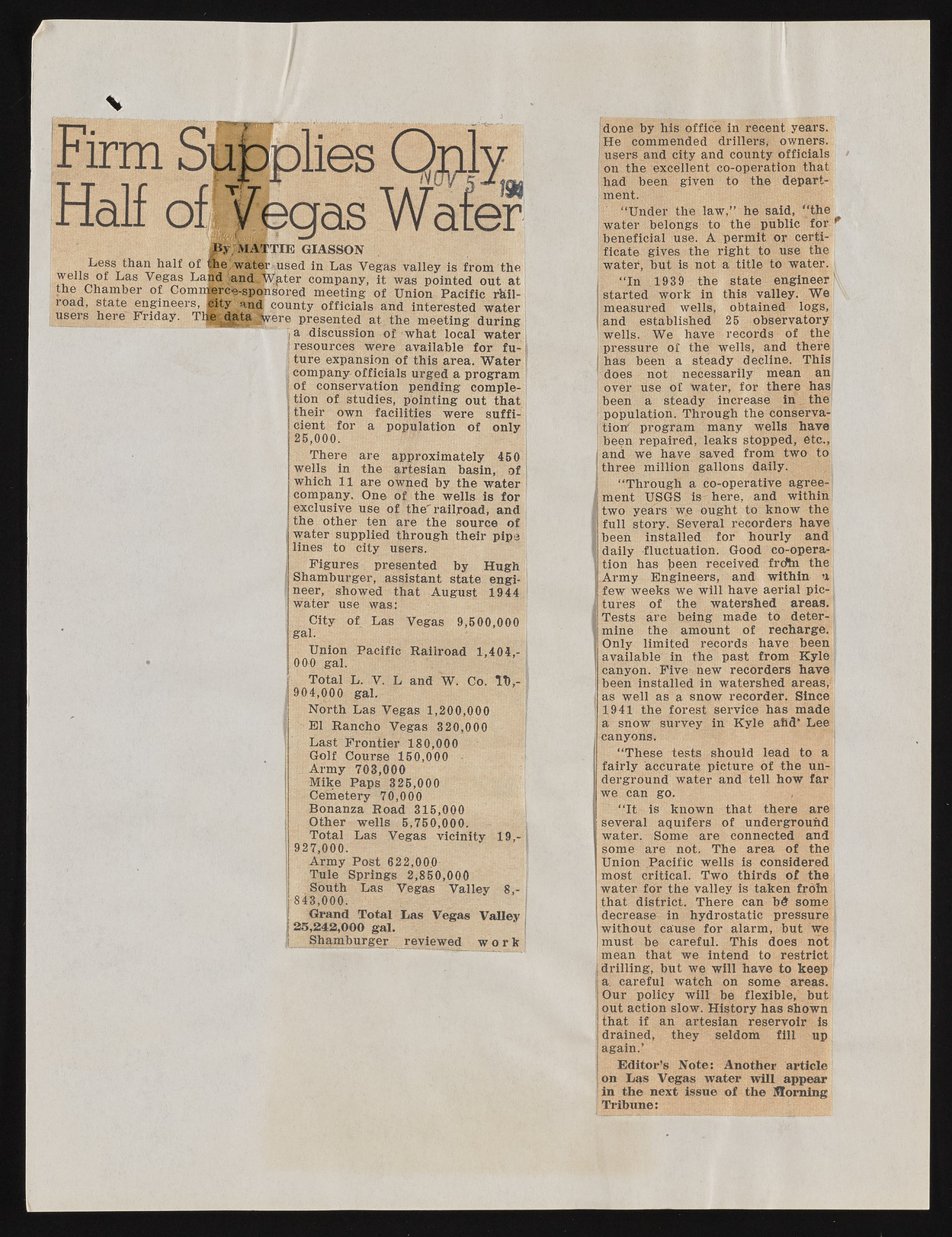Copyright & Fair-use Agreement
UNLV Special Collections provides copies of materials to facilitate private study, scholarship, or research. Material not in the public domain may be used according to fair use of copyrighted materials as defined by copyright law. Please cite us.
Please note that UNLV may not own the copyright to these materials and cannot provide permission to publish or distribute materials when UNLV is not the copyright holder. The user is solely responsible for determining the copyright status of materials and obtaining permission to use material from the copyright holder and for determining whether any permissions relating to any other rights are necessary for the intended use, and for obtaining all required permissions beyond that allowed by fair use.
Read more about our reproduction and use policy.
I agree.Information
Digital ID
Permalink
Details
Member of
More Info
Rights
Digital Provenance
Publisher
Transcription
V Less than half of (he .-water-.used in Las Vegas valley is from the wells of Las Vegas Land'and Wfiter company, it was pointed out at the Chamber of Comnferce-spojnsored meeting of Union Pacific rbil-load, state engineers, city and county officials and interested water users here Friday. Tlf; data jjyere presented at the meeting during I a discussion of what local water I resources were available for fu- | ture expansion of this area. Water , company- officials urged a program j; of conservation pending comple- I tion of studies, pointing out that their own facilities were sufficient for a population of only 25,000. There are approximately 450 wells in the artesian basin, of which 11 are owned by the water company. One of the wells is for exclusive use of the'railroad, and the other ten are the source of water supplied through their pipe I lines to city users. | Figures presented by Hugh | Shamburger, assistant state engineer, showed that August 1944 ?water use was: City of Las Vegas 9,500,000 gal. Union Pacific Railroad 1,404,- • |0OQ;;.gai, Total L. V. L and W. Co. 1D,- | 904,000 gal. I North Las Vegas 1,200,000 | El Rancho Vegas 320,000 j Last Frontier 180,000 j Golf Course 150,000 Army 703,000 Mike Paps 326,000 Cemetery 70,000 ! Bonanza Road 315,000 I Other wells 5,750,000. I Total Las Vegas vicinity 19,- ] 927,000. j Army Post 622,000 Tule Springs 2,850,000 South Las Vegas Valley 8,- ! 843,000. I Grand Total Las Vegas Valley 25,242,000 gal. I Shamburger reviewed w o r k 'done by his office in recent years. He commended drillers, owners. I users and city and county officials i on the excellent co-operation that had been given to the depart- | ment. “ Under the law,” he said, "the ! water belongs to the public for * \ beneficial use. A permit or certi- | ficate gives the right to use the water, but is not a title to water, j “ In 1939 the state engineer' started work in this valley. We measured wells, obtained logs, and established 25 observatory WeHs. We have records of the j pressure of the wells, and there has been a steady decline. This ' does not necessarily mean an j over use of water, for there has been a steady increase in, the I population. Through the conserva- | tion" program many wells have been repaired, leaks stopped, etc., and we have saved from two to three million gallons daily. “ Through a co-operative agree-j ment USGS is here, and within j two years we ought to know the 1 full story. Several recorders have I been installed for hourly and I daily fluctuation. Good co-opera- | tion has been received frcftn the Army Engineers, and within a j few weeks we will have aerial pic- | tures of the watershed areas.? I Tests are being made to deter- I mine the amount of recharge. Only limited records have been ! available in the past from Kyle canyon. Five new recorders have ! been installed in watershed areas,- j as well as a snow recorder. Since i 1941 the forest service has made a snow survey in Kyle afid* Lee j canyons. “ These tests should lead to a fairly accurate picture of the underground water and tell how far I we can go. “ It is known that there are I several aquifers of underground j water. Some are connected and some are not. The area of the Union Pacific wells is considered most critical. Two thirds of the water for the valley is taken frdfai that district. There can bd some decrease in hydrostatic pressure without cause for alarm, but we must be careful. This does not I mean that we intend to restrict J drilling, but we will have to keep a. careful watch on some areas. Our policy will be flexible, but , out action slow. History has shown ! that if an artesian reservoir is ; drained, they seldom fill up again.’ Editor’s Note: Another article on Las Vegas water will appear in the next issne o f the iRorning Tribune:

